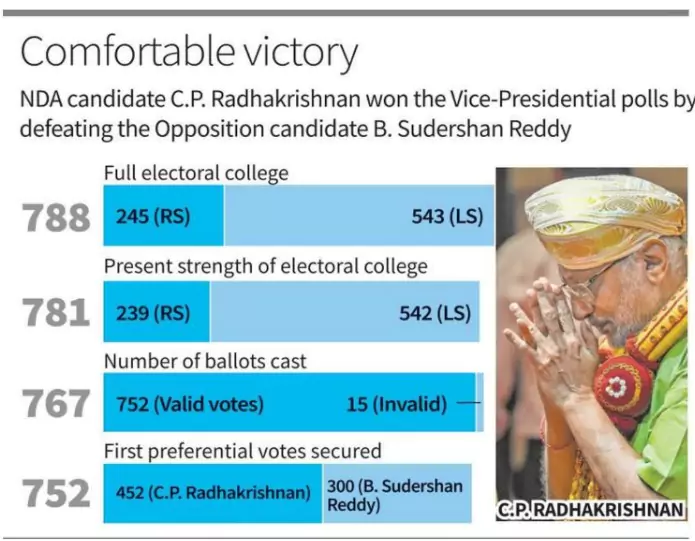NDA candidate C.P. Radhakrishnan won the Vice-Presidential election on September 9, 2025, securing 452 votes against Opposition nominee B. Sudershan Reddy, who received 300 votes.
About the Vice-President of India
- Constitutional Provision: The office of the Vice-President is provided under Article 63 of the Constitution.
- Position: Holds the second-highest constitutional office after the President of India.
Powers and Functions of the Vice-President
- Ex-officio Chairman of Rajya Sabha
- Presides over Rajya Sabha proceedings with powers similar to the Speaker of the Lok Sabha.
- Draws salary and allowances in this capacity.
- Holds the authority to cast a decisive vote in case of a tie.
- Acting as the President of India: Performs the duties of the President when:
- The office of President falls vacant due to resignation, impeachment, death, or any other reason (for a maximum of six months, until a new President is elected).
- The President is temporarily unable to discharge duties due to absence, illness, or other causes.
- During this period, the Vice-President does not act as Chairman of Rajya Sabha; those duties are performed by the Deputy Chairman.
- When functioning as President, the Vice-President receives the salary and allowances of the President, not those of the Rajya Sabha Chairman.
- Succession in Rajya Sabha: In case of the Vice-President’s resignation, removal, or death, the Deputy Chairman of Rajya Sabha discharges the functions of the Chairman.
Election Procedure of Vice President
- Constitutional Provision: Article 68 of the Constitution mandates that the election to fill a vacancy caused by the expiry of the Vice-President’s term must be completed before the incumbent demits office.
- Eligibility criteria for Vice-President (Article 66)
- The candidate must be a citizen of India.
- Must have completed 35 years of age.
- Must be qualified for election as a member of the Rajya Sabha.
- Must not hold any office of profit under the Government of India, State Government, or any local or other authority.
- Method of Election:
- The Vice-President is elected indirectly, not directly by the people.
- The electoral college consists of members of both Houses of Parliament, including both elected and nominated members.
Difference from Presidential Election
- Includes nominated members of Parliament (unlike the President’s election, which involves only elected members).
- Excludes state legislative assemblies (while in the President’s election, elected members of state legislatures participate).
|
- Election Process: Conducted under Article 324 of the Constitution, along with the provisions of the Presidential and Vice-Presidential Elections Act, 1952, and the Presidential and Vice-Presidential Elections Rules, 1974.
- As per Rule 8 of the Presidential and Vice-Presidential Elections Rules, 1974, polls for the election are taken in the Parliament House
- Voting System:
- Conducted by Election Commission of India in accordance with the system of proportional representation by means of the single transferable vote.
- Voting is by secret ballot.
- Election Disputes and Final Authority
- All doubts and disputes relating to the Vice-President’s election are decided by the Supreme Court, and its decision is final.
- The election cannot be challenged on the ground of an incomplete electoral college.
- If the election is declared void by the Supreme Court, acts done by the Vice-President prior to the declaration remain valid.
PW OnlyIAS Extra Edge
Proportional Representation (PR) System
- An electoral method in which seats are distributed to parties or candidates in proportion to the votes secured, ensuring fair representation for different groups in society.
Single Transferable Vote (STV)
- A form of proportional representation where voters rank candidates in order of preference.
 During counting, surplus votes of winning candidates or votes of candidates with the least support are transferred to remaining candidates until the required number of winners is elected. During counting, surplus votes of winning candidates or votes of candidates with the least support are transferred to remaining candidates until the required number of winners is elected.
Electoral College
- A body of elected representatives entrusted with the responsibility of formally electing the President or other constitutional office-bearers.
- It represents an indirect election system, where citizens elect representatives, and these representatives collectively cast votes to choose the office-holder.
|
Conditions of Office of the Vice President
- Membership Restriction: The Vice President cannot be a member of either House of Parliament or any State Legislature.
- If such a person is elected as Vice President, their seat in the concerned House is automatically vacated on the date they assume office.
- Office of Profit Restriction: The Vice President cannot hold any other office of profit during their tenure.
Term of Office of the Vice President
- Duration: Holds office for five years from the date of assuming charge.
- Resignation: Can resign at any time by addressing the resignation to the President.
- Removal:
- Can be removed by a resolution passed by the Rajya Sabha (effective majority) and agreed to by the Lok Sabha (simple majority).
- No impeachment process is required, and no grounds for removal are specified in the Constitution.
- The removal process can be initiated only in the Rajya Sabha.
- Notice Requirement: A minimum of 14 days’ notice must be given before moving the resolution in Rajya Sabha.
- Continuity: He/She can remain in office beyond the five-year term until the successor assumes charge.
- Re-election: Eligible for re-election for any number of terms.
Vacancy in the Office of Vice President
A vacancy can occur in the following cases:
- Expiry of Term – Completion of five years.
- Resignation – By formally resigning to the President.
- Removal – By a resolution of Parliament.
- Death – In case of demise during tenure.
- Other Grounds – Such as disqualification or invalidation of election.
- Filling the Vacancy:
- If due to expiry of term → election must be held before the term ends.
- If due to resignation, removal, death, or otherwise → election should be held as soon as possible.
- The newly elected Vice President serves a full five-year term from the date of assuming office.
Vice Presidents of India
| Election Year |
Vice President Elected |
| 1952 |
Dr. S. Radhakrishnan |
| 1957 |
Dr. S. Radhakrishnan |
| 1962 |
Dr. Zakir Hussain |
| 1967 |
V. V. Giri |
| 1969 |
G. S. Pathak |
| 1974 |
B. D. Jatti |
| 1979 |
M. Hidayatullah |
| 1984 |
R. Venkataraman |
| 1987 |
Dr. Shankar Dayal Sharma |
| 1992 |
K. R. Narayanan |
| 1997 |
Krishna Kant |
| 2002 |
B. S. Shekhawat |
| 2007 |
Mohd. Hamid Ansari |
| 2012 |
Mohd. Hamid Ansari |
| 2017 |
M. Venkaiah Naidu |
| 2022 |
Jagdeep Dhankhar |
| 2025 |
C. P. Radhakrishnan |
Vice-Presidents Who Became Presidents of India
| Dr. S. Radhakrishnan |
1962 |
| Dr. Zakir Hussain |
1967 |
| V. V. Giri |
1969 |
| R. Venkataraman |
1987 |
| Dr. Shankar Dayal Sharma |
1992 |
| K. R. Narayanan |
1997 |
![]() 10 Sep 2025
10 Sep 2025

